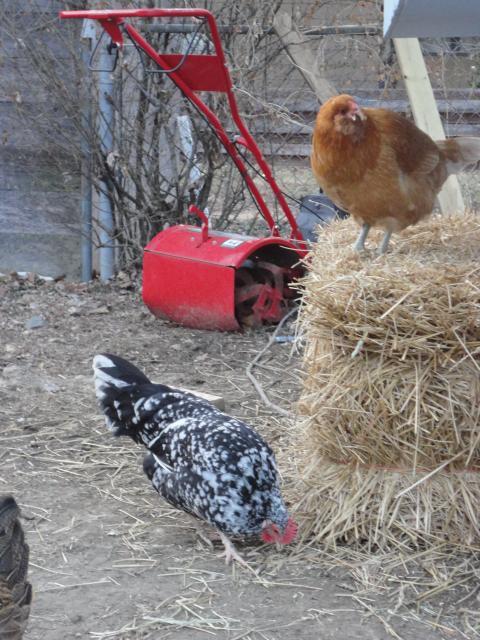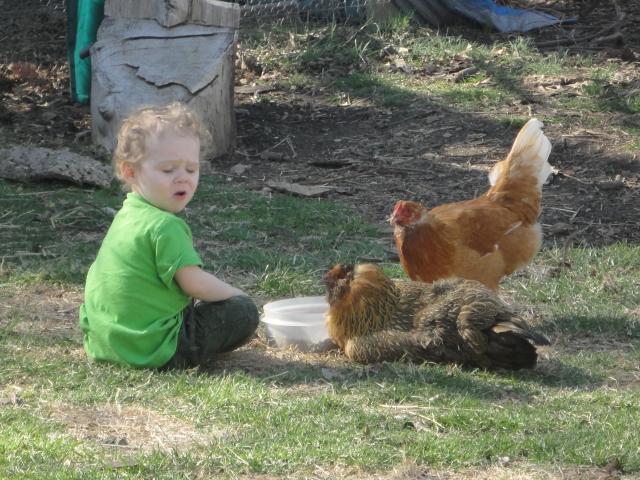When we got chickens, my husband was adamant that once they were past laying usefulness they would be going in the pot. I wasn't so sure I could do that to a bird I had named and raised from a day old chick. Well, turns out I can in large part thanks to the wonderful and helpful people here on BYC. I won't say it was easy, but it wasn't so bad that I can't see us doing it again in the not too distant future. We processed 3 of our year and a half old hens; two EE and our exchequer leghorn. The EE both had health issues (cross beak and reproductive issues) and the leghorn was just mean to the other chickens and laid small eggs.
The actual dispatching was, as expected, the hardest part. We used a brand new box cutter purchased specifically for this purpose, and had a really hard time making the cut. We didn't manage to cut the jugular on the first or even second cuts on any of the birds
 That was the absolute worst, the feeling that we prolonged their suffering because of our own inexperience. Thankfully, none of them seemed stressed while we fumbled about getting the job done. I was surprised how quickly they passed once the correct cut was made, and how little blood there was. Many thanks to whoever suggested using plastic grocery bags and duct tape as a "killing cone," it helped immensely. As did Redneck Mommy's suggestion of lining a bucket with a black trash bag and hanging them into the bucket while they bled, that I think was what helped keep them so calm through the whole ordeal. It also kept our garage clean and made clean up super easy.
That was the absolute worst, the feeling that we prolonged their suffering because of our own inexperience. Thankfully, none of them seemed stressed while we fumbled about getting the job done. I was surprised how quickly they passed once the correct cut was made, and how little blood there was. Many thanks to whoever suggested using plastic grocery bags and duct tape as a "killing cone," it helped immensely. As did Redneck Mommy's suggestion of lining a bucket with a black trash bag and hanging them into the bucket while they bled, that I think was what helped keep them so calm through the whole ordeal. It also kept our garage clean and made clean up super easy.
Scalding went well, although we started the pot of water in the house before moving it out to the back patio on the grill and got it way too hot so we had to wait (and add ice) for it to cool down to the right temp. Plucking was way easier than I had imagined. Even on the last hen who we didn't swish quite enough as the feathers were still dry and fluffy down near the skin. I dare say it was almost "fun." Peeling the feet was also way easier than I thought it would be and was definitely kind of fun. It reminded me of peeling old skin off a reptile that was shedding, right down to popping the toenails off.
We moved inside to the dining room table to finish up. We have an orange polka-dot vinyl tablecloth that is now our chicken processing table cloth (blood really is good at staining). Getting the head and neck off was probably the hardest part for me. I'm not sure if I just needed a better knife, or more muscle and less squeemishness about breaking bones/necks. But it made me very glad that we chose to use the bleeding method for dispatching rather than the cervical dislocation method as judging by how much trouble I had getting the head off I suspect I would have botched that method even worse than we did the cutting. Once we got the heads and feet off, they no longer resembled "our" chickens and it was much easier to think of them as simply food and not the almost-pets that they have been for the last year and a half. The evisceration was distinctly different for each bird. The leghorn had stopped laying for the season, so she just had a few small undeveloped ovum. The cross beak was still a regular layer, and when we opened her up we found an albumin sac and several yolks. The second EE was, as we suspected, an internal layer and had nasty chunky yolk debris in her reproductive tract. It made me very glad that we decided to process her as it confirms that it was only just a matter of time before she suffered from egg yolk peritonitis or egg binding. She also had a huge gizzard! It was at least twice as big as the other two, and the muscle was very dark. I guess it shouldn't really surprise me much since she was our best forager. She also had a lot more abdominal fat and a more yellowish liver than the other two. I was undoubtedly better at this part than my husband, both because I have lots of experience cutting up store bought birds into parts and because my hands are smaller. Turns out my hands are just about the perfect size to fit into the cavities of our chickens.
All in all, it was not an entirely unpleasant experience. Just unpleasant enough that I don't question my humanity, and not so unpleasant that I don't plan to do it again. RIP Merna, Buffy, and Celeste. Thank you for your sacrifice, and we sincerely hope that today's experience was not quite as horrible for you as we perceived it to be.

Buffy and Celeste

Merna and Buffy relaxing in the backyard with my son
The actual dispatching was, as expected, the hardest part. We used a brand new box cutter purchased specifically for this purpose, and had a really hard time making the cut. We didn't manage to cut the jugular on the first or even second cuts on any of the birds

Scalding went well, although we started the pot of water in the house before moving it out to the back patio on the grill and got it way too hot so we had to wait (and add ice) for it to cool down to the right temp. Plucking was way easier than I had imagined. Even on the last hen who we didn't swish quite enough as the feathers were still dry and fluffy down near the skin. I dare say it was almost "fun." Peeling the feet was also way easier than I thought it would be and was definitely kind of fun. It reminded me of peeling old skin off a reptile that was shedding, right down to popping the toenails off.
We moved inside to the dining room table to finish up. We have an orange polka-dot vinyl tablecloth that is now our chicken processing table cloth (blood really is good at staining). Getting the head and neck off was probably the hardest part for me. I'm not sure if I just needed a better knife, or more muscle and less squeemishness about breaking bones/necks. But it made me very glad that we chose to use the bleeding method for dispatching rather than the cervical dislocation method as judging by how much trouble I had getting the head off I suspect I would have botched that method even worse than we did the cutting. Once we got the heads and feet off, they no longer resembled "our" chickens and it was much easier to think of them as simply food and not the almost-pets that they have been for the last year and a half. The evisceration was distinctly different for each bird. The leghorn had stopped laying for the season, so she just had a few small undeveloped ovum. The cross beak was still a regular layer, and when we opened her up we found an albumin sac and several yolks. The second EE was, as we suspected, an internal layer and had nasty chunky yolk debris in her reproductive tract. It made me very glad that we decided to process her as it confirms that it was only just a matter of time before she suffered from egg yolk peritonitis or egg binding. She also had a huge gizzard! It was at least twice as big as the other two, and the muscle was very dark. I guess it shouldn't really surprise me much since she was our best forager. She also had a lot more abdominal fat and a more yellowish liver than the other two. I was undoubtedly better at this part than my husband, both because I have lots of experience cutting up store bought birds into parts and because my hands are smaller. Turns out my hands are just about the perfect size to fit into the cavities of our chickens.
All in all, it was not an entirely unpleasant experience. Just unpleasant enough that I don't question my humanity, and not so unpleasant that I don't plan to do it again. RIP Merna, Buffy, and Celeste. Thank you for your sacrifice, and we sincerely hope that today's experience was not quite as horrible for you as we perceived it to be.

Buffy and Celeste

Merna and Buffy relaxing in the backyard with my son




